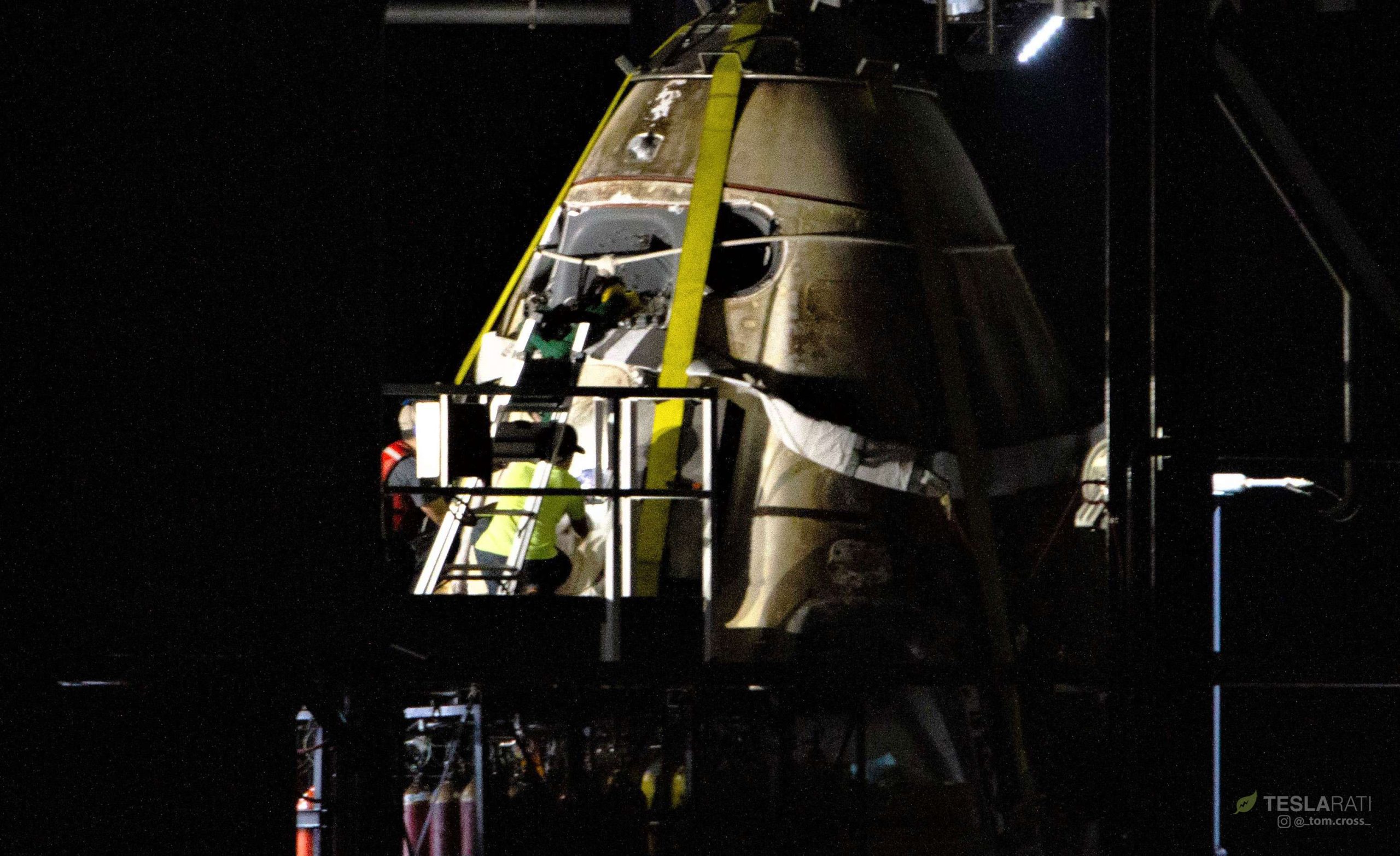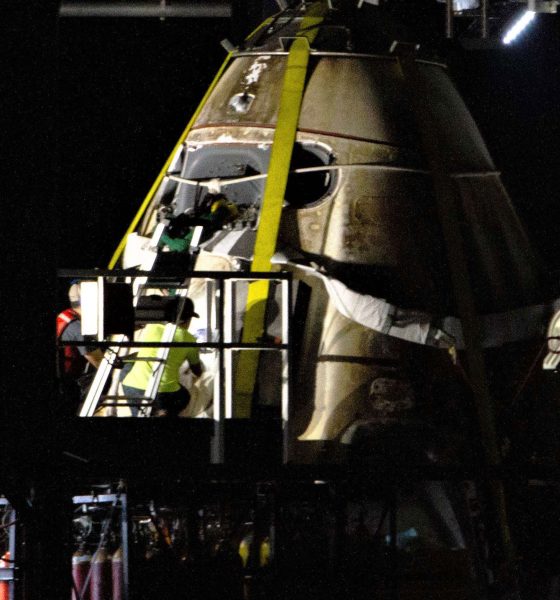

SpaceX
SpaceX’s Crew Dragon returns to port as NASA praises successful launch debut
SpaceX’s Crew Dragon spacecraft successfully returned to Port Canaveral aboard recovery vessel GO
The culmination of the better part of a decade of constant work and NASA support, the flawless success of SpaceX’s DM-1 Crew Dragon mission is a testament – above all else – to the many hundreds of thousands or millions of hours SpaceX employees have put into the spacecraft’s design, production, operation, and recovery. While just one half of a critical pair of demonstrations, DM-1’s success should translate into extremely good odds for Crew Dragon’s Demo Mission 2 (DM-2), in which SpaceX will launch two NASA astronauts to the International Space Station on the company’s first crewed launch ever.
“I can’t believe how well the whole mission has gone. I think on every point, everything’s been nailed, all the way along—particularly this last piece. We were all very excited to see re-entry and parachute and drogue deploy and main deploy, splashdown—everything happened just perfectly, right on time the way that we expected it to. It was beautiful.” – Benji Reed, Director of Crew Mission Management, SpaceX
SpaceX Director of Crew Mission Management Benji Reed’s unqualified appraisal of Crew Dragon’s debut serves as a perfect example of the attitude almost universal throughout the company in the twilight of the mission’s completion. While sources suggest that there were more than a few hiccups during the mission, they were extremely mild and came as no surprise for what effectively amounted to the first shakeout mission of a brand new vehicle. According to CEO Elon Musk, Crew Dragon shares almost no hardware – aside from its Draco thrusters – with Cargo Dragon, the uncrewed orbital spacecraft SpaceX has now launched into orbit 17 times in the last eight years.

Crew Dragon approaches the ISS during its orbital launch debut, March 3rd. (NASA) 
Cargo Dragon is seen here attached to the ISS shortly before the completion of SpaceX’s CRS-16 resupply mission, January 7th. (NASA) 
Crew Dragon was successfully recovered aboard GO Searcher on March 8th. (SpaceX) 
Cargo Dragon completed its most recent mission, CRS-16, on January 13th. (SpaceX)
For such a complex spacecraft, not to mention an almost clean-sheet redesign, it’s nothing short of extraordinary that its debut launch was so utterly free of significant anomalies or unexpected behavior. Separated into the distinct phases of launch, free-flight, ISS docking/undocking, and recovery, Crew Dragon reportedly performed almost perfectly in all cases, “right on time” according to Mr. Reed. NASA’s CCP Deputy Manager Steve Stich was equally enthusiastic and elated about the spacecraft’s performance.
“On-orbit we got a lot of great data on the vehicle in terms of the thermal performance and power performance; the vehicle really did better than we expected. Then the rendezvous was phenomenal as we came in and checked out those sensors. Today; the undocking, watching how those systems performed, that went flawlessly. It’s a very tight sequence between undocking and de-orbit burn, how the nose cone performed, how the de-orbit burn was executed, then the entry was phenomenal.”
“I don’t think we saw really anything in the mission so far—and we’ve got to do to the data reviews—that would preclude us from having the crewed mission [DM-2] later this year.”
– Steve Stich, CCP Deputy Manager, NASA
Following Crew Dragon’s March 9/10 return to Port Canaveral, the spacecraft is expected to immediately enter into a post-flight analysis and data-gathering phase that will quickly transfer into refurbishment to prepare for the capsule’s second (albeit suborbital) launch, a critical in-flight abort (IFA) test that could happen as early as April according to Elon Musk. While official planning schedules point towards the IFA occurring closer to June or even July, it’s reasonable to assume that those official schedules are highly conservative. If Crew Dragon’s significantly waterproofing and reusability upgrades make a major difference, it’s far from inconceivable that the vehicle’s second abort test could actually occur ahead of schedule, although it’s unlikely.
The in-flight abort test will effectively be a repeat of SpaceX’s successful 2015 pad abort demonstration, albeit with the stationary launch pad replaced with a full Falcon 9 rocket – first and second stage – traveling at supersonic speeds. If Crew Dragon can safely abort in such challenging conditions, it’s almost guaranteed that it will be able to safely abort at any time during a Falcon 9 launch, all the way from the moment fueling begins on the ground into orbital operations. In fact, CEO Elon Musk recently suggested that the same SuperDraco abort thrusters that enable those safe escapes could potentially be used to add yet another level of redundancy during landing, standing in for parachute damage or failures to slow the capsule down and minimize or prevent injuries during splashdown.
Check out Teslarati’s Marketplace! We offer Tesla accessories, including for the Tesla Cybertruck and Tesla Model 3.

Elon Musk
Elon Musk’s Biggest Revelations on AI, Robots, and the Future of Work from the Moonshots Podcast

Elon Musk’s appearance on the Moonshots with Peter Diamandis podcast was packed with bold predictions, candid admissions, and surprising tech insights. The nearly three-hour conversation covered everything from artificial intelligence to humanoid robots, geopolitics, and the future of work. Here are the top 10 most intriguing takeaways:
-
Aggressive AGI Timeline Predictions
Musk offered a detailed view on when artificial general intelligence (AGI) could emerge, suggesting it may arrive sooner than many expect, emphasizing both transformative potential and risks.
-
U.S. vs. China in the AI Race
He discussed the strategic competition between the United States and China over AI development, noting that geopolitical dynamics will shape how and who leads in the next decades.
-
Future of Job Markets
Musk touched on how AI and automation could reshape employment, predicting massive boosts in productivity alongside potential disruptions in traditional work structures.
-
Clean Energy Transition
A recurring theme was the role of clean energy in future economies, with Musk reiterating the importance of scaling sustainable power generation and storage.
-
Humanoid Robots Are Coming
On the podcast, Musk elaborated on Tesla’s work on humanoid robots, hinting at timelines and applications that go beyond factories to general-purpose assistance.
-
Tesla Roadster “Last Human-Driven Car”
Outside the core discussion topics, Musk teased features of the upcoming Tesla Roadster — calling it “the best of the last of the human-driven cars” and suggesting safety won’t be its main selling point.
-
The Role of AI in Clean Energy and Robotics
Linking AI to both energy optimization and robotics, Musk explained how smarter systems could accelerate decarbonization and task automation across industries.
-
U.S. Innovation Leadership
Musk argued that maintaining American leadership in key tech sectors like AI, space, and robotics should be a national priority, with thoughtful policy and investment.
-
Job Creation vs. Job Elimination
While acknowledging automation’s disruptive effects, he also outlined scenarios where new industries and opportunities could emerge, particularly in AI, space, and advanced manufacturing.
-
Long-Term Vision for Humanity
Throughout the conversation, Musk revisited his long-term philosophical views — including a belief in humanity’s responsibility to become a multi-planetary and technologically empowered species.
Whether you agree with Musk’s optimism or not, the podcast offers a window into the thinking of one of the most influential figures in tech today, in and why his visions continue to spark debate and inspiration.
Elon Musk
Starlink achieves major milestones in 2025 progress report
Starlink wrapped up 2025 with impressive growth, adding more than 4.6 million new active customers and expanding service to 35 additional countries, territories, and markets.

Starlink wrapped up 2025 with impressive growth, adding more than 4.6 million new active customers and expanding service to 35 additional countries, territories, and markets. The company also completed deployment of its first-generation Direct to Cell constellation, launching over 650 satellites in just 18 months to enable cellular connectivity.
SpaceX highlighted Starlink’s impressive 2025 progress in an extensive report.
Key achievements from Starlink’s 2025 Progress
Starlink connected over 4.6 million new customers with high-speed internet while bringing service to 35 more regions worldwide in 2025. Starlink is now connecting 9.2 million people worldwide. The service achieved this just weeks after hitting its 8 million customer milestone.
Starlink is now available in 155 markets, including areas that are unreachable by traditional ISPs. As per SpaceX, Starlink has also provided over 21 million airline passengers and 20 million cruise passengers with reliable high-speed internet connectivity during their travels.
Starlink Direct to Cell
Starlink’s Direct to Cell constellation, more than 650 satellites strong, has already connected over 12 million people at least once, marking a breakthrough in global mobile coverage.
Starlink Direct to Cell is currently rolled out to 22 countries and 6 continents, with over 6 million monthly customers. Starlink Direct to Cell also has 27 MNO partners to date.
“This year, SpaceX completed deployment of the first generation of the Starlink Direct to Cell constellation, with more than 650 satellites launched to low-Earth orbit in just 18 months. Starlink Direct to Cell has connected more than 12 million people, and counting, at least once, providing life-saving connectivity when people need it most,” SpaceX wrote.
Elon Musk
Starlink passes 9 million active customers just weeks after hitting 8 million
The milestone highlights the accelerating growth of Starlink, which has now been adding over 20,000 new users per day.

SpaceX’s Starlink satellite internet service has continued its rapid global expansion, surpassing 9 million active customers just weeks after crossing the 8 million mark.
The milestone highlights the accelerating growth of Starlink, which has now been adding over 20,000 new users per day.
9 million customers
In a post on X, SpaceX stated that Starlink now serves over 9 million active users across 155 countries, territories, and markets. The company reached 8 million customers in early November, meaning it added roughly 1 million subscribers in under seven weeks, or about 21,275 new users on average per day.
“Starlink is connecting more than 9M active customers with high-speed internet across 155 countries, territories, and many other markets,” Starlink wrote in a post on its official X account. SpaceX President Gwynne Shotwell also celebrated the milestone on X. “A huge thank you to all of our customers and congrats to the Starlink team for such an incredible product,” she wrote.
That growth rate reflects both rising demand for broadband in underserved regions and Starlink’s expanding satellite constellation, which now includes more than 9,000 low-Earth-orbit satellites designed to deliver high-speed, low-latency internet worldwide.
Starlink’s momentum
Starlink’s momentum has been building up. SpaceX reported 4.6 million Starlink customers in December 2024, followed by 7 million by August 2025, and 8 million customers in November. Independent data also suggests Starlink usage is rising sharply, with Cloudflare reporting that global web traffic from Starlink users more than doubled in 2025, as noted in an Insider report.
Starlink’s momentum is increasingly tied to SpaceX’s broader financial outlook. Elon Musk has said the satellite network is “by far” the company’s largest revenue driver, and reports suggest SpaceX may be positioning itself for an initial public offering as soon as next year, with valuations estimated as high as $1.5 trillion. Musk has also suggested in the past that Starlink could have its own IPO in the future.








